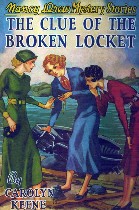 Carolyn Keene •
Carolyn Keene •
The Clue of the Broken Locket •
Not long ago I came across what’s called a facsimile version of The Clue of the Broken Locket, an Applewood Books edition that reproduces the original 1934 text. I read it side by side with the later book by the same name, and what I found astonished me.
I had expected to see the language updated (flashlight instead of electric torch), the action streamlined, the racial stereotypes expunged. True enough, as far as it went.
But I also found a completely different book, one whose story line bears no resemblance to the 1965 version. Characters, setting, plot—none of these are even close. Apart from the title, the only unchanged elements are that both books involve broken lockets, for obvious reasons, and twins. And there the similarity starts and ends.
But the biggest surprise was Nancy herself. The Nancy Drew of 1934 is not only more fleshed out. She’s feistier. She’s funnier. She slams doors, teases her father, induces Bess to drain the water from a pursuer’s radiator. She breaks the speed limit. And she listens to a tiny internal voice that tells her what to do.
Somehow Nancy got toned down in the revisions, her cheeky nature tamed. She lost a lot of her sparkle and gumption. It’s as if she suddenly became conscious that she was a role model, and adjusted her behavior accordingly.
I still love Nancy Drew in all her personas, but I admit to preferring the meddlesome, firebrand Nancy of 80 years ago. If you can, get your hands on an Applewood Book to better understand the origins of the girl detective and why she took America by storm way back when. You’ll be glad you met 1934 Nancy.






Your email address will not be published.